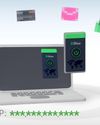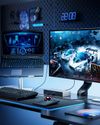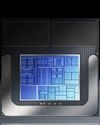It really needs a piece of pie.

Samsung passed up a golden opportunity with the Galaxy Note 9 (go. pcworld.com/gn9). Just days before the Note 9 shipped, Google officially launched Android 9 Pie (go.pcworld.com/a9p), bringing a brand new way to navigate, smarter notifications, and indoor mapping with Wi-Fi RTT. The world’s most dominant mobile platform reinvented itself to stay ahead of the ever-changing smart phone landscape.
But you wouldn’t know it by looking at the Note 9. Samsung launched its new $1,000 phone with Android Oreo 8.1, an OS that’s technically newer but nearly indistinguishable from the one that’s running on the Galaxy S9 (go.pcworld.com/gs9). And instead of making a statement to the Android community that it will not only make the best hardware but pair it with the best software, Samsung continued to treat Android as a necessary burden standing in the way of its vision.
Instead of giving would-be Note 9 buyers the best of both worlds—the highest-end hardware with the freshest software—Samsung’s latest handset runs the same version of Android that Pixel users downloaded more than eight months ago. Mind you, this is nothing new for anyone who’s used a Samsung phone, but it could have been different with the Note 9. And customers might finally be starting to notice.
SPECS AND PERFORMANCE AREN’T THE SAME
I’ve been using the Galaxy Note 9 for a few days now and there’s a lot to like about it, especially if you’re a power user. But while the Snapdragon 845 processor, 4,000mAh battery, and 128GB of storage are all best in class, the OS feels like a step behind. It’s not just that it’s missing smart little features like manual orientation lock and proper volume controls, it’s that the Note 9 feels like a phone that could have released a year ago.
Diese Geschichte stammt aus der September 2018-Ausgabe von PCWorld.
Starten Sie Ihre 7-tägige kostenlose Testversion von Magzter GOLD, um auf Tausende kuratierte Premium-Storys sowie über 8.000 Zeitschriften und Zeitungen zuzugreifen.
Bereits Abonnent ? Anmelden
Diese Geschichte stammt aus der September 2018-Ausgabe von PCWorld.
Starten Sie Ihre 7-tägige kostenlose Testversion von Magzter GOLD, um auf Tausende kuratierte Premium-Storys sowie über 8.000 Zeitschriften und Zeitungen zuzugreifen.
Bereits Abonnent? Anmelden

Private Internet Access: A low-price, high-value VPN for everyone
This veteran VPN shows it can still hang with the best.

Hands-on: Kensington's first Thunderbolt 5 dock is built for the future
Thunderbolt 5 is here...but you'll need more than just this well-built Kensington dock to take advantage of it.

Tested: Intel's Lunar Lake chip wants you to forget Qualcomm laptops exist
Great battery life, mediocre performance, surprisingly decent gaming: That is how Intel's Lunar Lake chip stacks up.

7 laptop habits that coax the most out of your battery
Don't send your laptop into an early grave.

WordPad is gone from Windows 11. Here's how to bring it back
With the arrival of Windows 11 version 24H2, WordPad is officially gone. Want to keep using it? You're in luck.

Hackers know your social security number. Here's how to stay safe
Thanks to a multitude of data leaks, your most sensitive information is now easily accessible to the world.

20 insanely useful Windows 11 keyboard shortcuts I use every day
After so many years, I'm still discovering new keyboard shortcuts.

WHAT THE HECK IS AN NPU, ANYWAY? HERE'S AN EXPLAINER ON AI CHIPS
ALL PCS WILL SOON HAVE NEURAL PROCESSING UNITS. HERE'S WHAT THAT MEANS FOR YOU IN SIMPLE TERMS.

WINDOWS 11'S 2024 UPDAATE: 5 BIG CHANGES I REALLY LIKE (AND MORE)
WINDOWS 11'S ANNUAL UPDATE IS ROLLING OUT OVER THE NEXT FEW WEEKS.

Hackers are using AI-generated code for malware attacks
Two separate attacks have been spotted using code that was probably written by artificial intelligence.